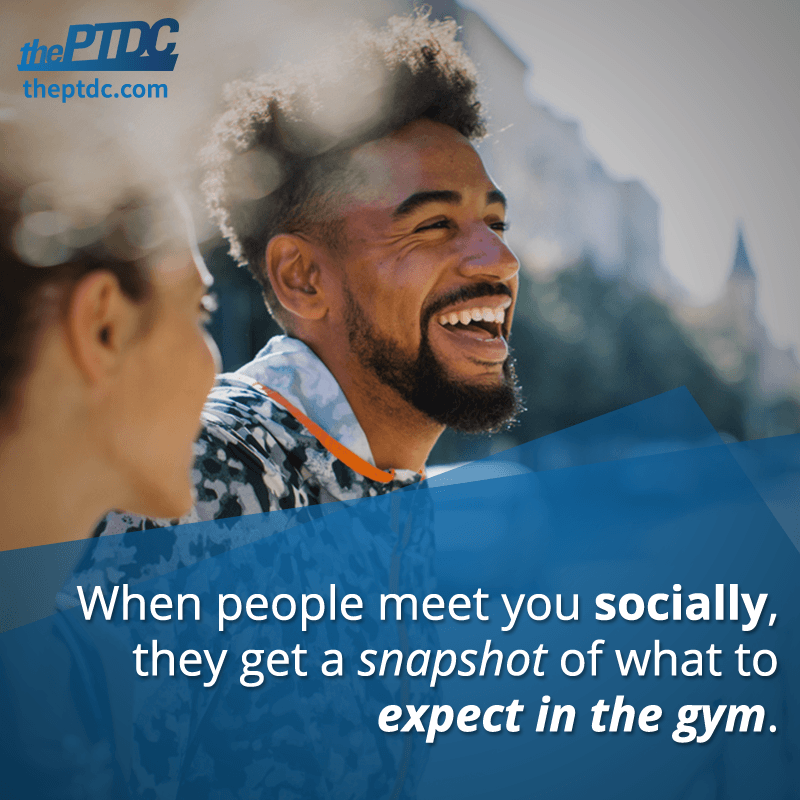Four months ago, after a long week of sessions and in lieu of my typical downtime on the weekend, I attended two different social events with clients: a 30th birthday party and a wedding.
To some trainers, this may seem strange. Aren’t we supposed to remain clinically detached from our paying customers?
In fact, good personal trainers create deep connections with their clients. Sometimes this means being a part of some of the biggest moments in a client’s life. Other times you can attend or even create social activities that give you valuable insights into your clients’ needs and expand your business, all without compromising your professionalism or your working relationship.
How Socializing Helps You Get New Business
1. It Gets You Into the Conversation
Word-of-mouth marketing is the lifeblood of our business. Personal training is a commitment of both time and money, and prospects want to be sure they’re choosing a good fit. Having social proof in the form of rave reviews from your current clients—your prospect’s friends, family and colleagues—can be the tipping point that gets them to sign on as a client.
But rave reviews aren’t enough. No matter how satisfied your clients are, you probably won’t be top of mind when they’re with friends. But if you’re in the room, an unfamiliar face, there’s a natural curiosity , and an opportunity for your happy client to brag about you.
Here’s an example:
A client invited me to a barbecue she hosted. The guests included friends and coworkers who already knew each other. Since I was the oddball, every conversation started with something like, “How do you know the host?”
I would reply, “I’m her personal trainer.”
I could see their eyes light up. “Oh! She looks fantastic! I’ve been thinking about getting a trainer for a while now …”
Boom. New prospect.
2. It Allows Prospects to Test-Drive Your Personality
Your personality can make or break your career. You want to make clients feel comfortable, inspired, and supported, and also be someone they enjoy spending time with. When a prospect meets you at a social event, she gets a snapshot of what she can expect from you in the gym. Do they like the way you explain ideas? Do you make them feel good about themselves, or inspire them?
It’s a low-risk way to test-drive your personality to see if it’s a good fit. If you mesh well, it could be enough to convince them to come in for a consultation.
At my client’s wedding, the one I mentioned at the beginning, I spent most of the evening chatting with the sister of the bride. We talked about music, our thoughts on wedding receptions, our favorite drinks—everything except fitness.
She called a week later. It was time to work with a trainer, and because she enjoyed our conversation, she thought of me. She’s been a loyal client ever since.
3. It Expands Your Social Networks
In 1973, sociologist Mark Granovetter, PhD, published “The Strength of Weak Ties,” a landmark study that redefined social networks. His goal was to show “how interaction in small groups aggregates to form large-scale patterns.”
The basic idea: All of us have an assortment of strong and weak ties within our networks. Strong ties are those close friends and family members with whom you share frequent contact, and share access to the same information and opportunities.

The advantage of weak ties—relationships that involve much less frequent contact or intimacy—is that they give you access to new opportunities and information. By interacting with your clients outside the gym, you create weak ties within their social networks. Those weak ties open the door to new prospective customers.
How Socializing Helps Your Current Clients
1. It Helps You See Their Big-Picture Goals
The goals clients tell you about during their sessions don’t always depict what they ultimately want. They’re often stepping stones to something much larger. Meeting clients outside the gym can give you clues to this bigger picture, and in turn help you keep those clients motivated and dedicated to their fitness plan.
A great example is a conversation I had with a long-time, off-and-on client at a social gathering we hosted. She told me how much anxiety she has about exercise.
I had no idea, but it made sense: Someone with anxiety surrounding the thing you do isn’t likely to just come out and tell you about it. Now that I knew, though, I could take it into consideration when we trained together.
2. It Helps You Connect with Clients in Their Element
If you work in a gym, it’s your natural habitat, and it’s where clients are most likely to see you. That’s why it’s so useful to see clients in their element. What’s their environment outside the gym? How do they interact with friends and family? Do you see any potential barriers to their progress?
When I arrived at the 30th birthday party I mentioned earlier, I noticed two distinct groups of people. There was a lot of socializing within each group, and not much between groups. I eventually figured out why.
In one group were the client’s longtime friends, the people she grew up with. The other consisted of her work friends. While she was clearly close to all of them, I noticed how her behavior changed as she went from one to the other.
With her work friends she was more self-conscious about what she did and how she presented herself. She didn’t snack as much, and sipped her drink more slowly. But with her childhood friends she let loose, taking shots when prompted or sharing bites of desserts.
And the way she behaved with both groups was different from how she presented herself in the gym with me. Noting these differences gave me insight into the challenges she faces, and how her interactions with these separate groups might affect her ability to reach her goals.
3. It Inspires You to Be a Better Coach
After a while, when you’ve built a full roster of clients, it’s easy to fall into the trap of reducing them to their numerical output: how much they’ve lost, how much they’ve lifted, how much they’ve progressed in an assessment or exercise.

But when you see them outside your structured environment, where they move with newfound confidence, it’s not just exciting for them. It’s invigorating for you. You’ll return to the gym with a new sense of purpose, knowing the real-world effect you have and how significant you are in their lives.
How to Create Social Events for Clients and Their Friends
Here’s the best part: You don’t have to wait for a client to invite you somewhere. You can be the one to get the ball rolling.
At A-Team Fitness, we plan holiday parties, bowling events, rock-climbing adventures, and any other event we can think of. It might be active or purely social. Our goal is to put ourselves at the social epicenter of our fitness community. The key is to pick something everyone can participate in, whether it’s at the gym or somewhere else.
We also encourage clients to invite their friends and family. Of course that helps us meet new prospects, but it also helps us strengthen our connections among existing clients. We’re hardly the only ones who do this. In fact, it seems to be a growing trend.
That brings me to those words in the headline: dinner with clients.
Mark Zarate, owner of Zarate Fitness in Armada, Michigan, routinely organizes group dinners with clients. “Everybody is invited—friends, family, whomever,” he says. Conversations are rarely about fitness. They’ll talk about their lives, and about life in general.
How does not talking about business help his business? “When we’re out, it’s almost inevitable that we’ll run into friends of friends,” he says. “It sparks conversations about our fitness groups, and how great they are.” He’ll end up with contact info for future clients without even asking for it.
Which is yet another way that socializing with clients, in or out of the gym, helps everyone concerned.
- You expand your marketing reach through your clients’ social networks. Prospects can see the quality of your work with their friend, and also get a sense of your personality, and whether they’d want you in their lives for a couple of hours a week.
- You learn more about your current clients when you’re outside a workout setting, both from what they tell you and what you observe as they interact with friends and family. The better you understand them, the more effective you can be as a trainer.
- Prospects see how you interact with your existing clients, how they interact with each other, and how together you form a community.
But the best part may have nothing to do with business at all. When you connect with clients on a deeper level, when you watch them overcome their fears, when you see them project their newfound confidence, you remember why you wanted to be a trainer to begin with.










